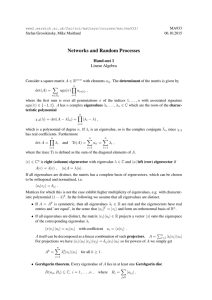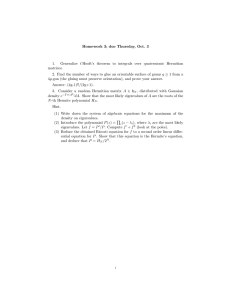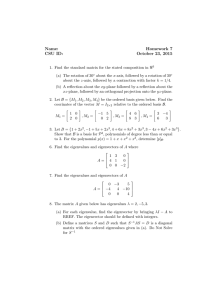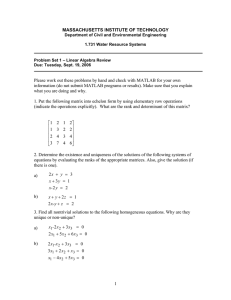Estimates eigenvalues of fourth-order weighted polynomial operator on a hyperbolic space
advertisement
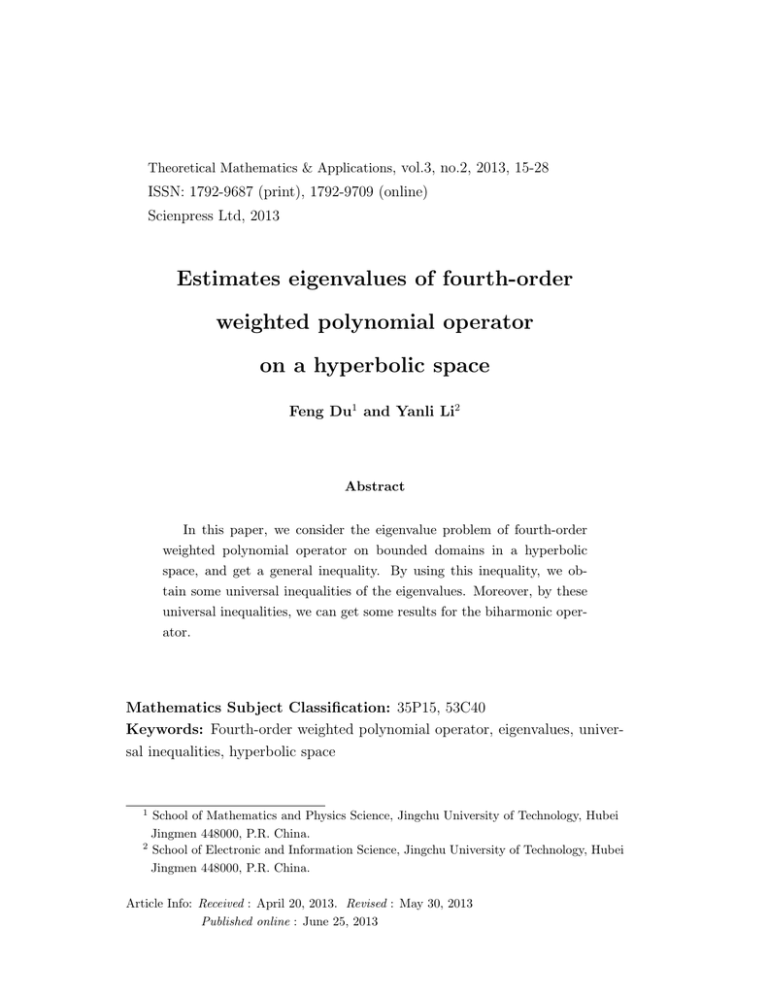
Theoretical Mathematics & Applications, vol.3, no.2, 2013, 15-28
ISSN: 1792-9687 (print), 1792-9709 (online)
Scienpress Ltd, 2013
Estimates eigenvalues of fourth-order
weighted polynomial operator
on a hyperbolic space
Feng Du1 and Yanli Li2
Abstract
In this paper, we consider the eigenvalue problem of fourth-order
weighted polynomial operator on bounded domains in a hyperbolic
space, and get a general inequality. By using this inequality, we obtain some universal inequalities of the eigenvalues. Moreover, by these
universal inequalities, we can get some results for the biharmonic operator.
Mathematics Subject Classification: 35P15, 53C40
Keywords: Fourth-order weighted polynomial operator, eigenvalues, universal inequalities, hyperbolic space
1
School of Mathematics and Physics Science, Jingchu University of Technology, Hubei
Jingmen 448000, P.R. China.
2
School of Electronic and Information Science, Jingchu University of Technology, Hubei
Jingmen 448000, P.R. China.
Article Info: Received : April 20, 2013. Revised : May 30, 2013
Published online : June 25, 2013
16
1
Estimates eigenvalues of fourth-order weighted polynomial operator
Introduction
Let Ω be a bounded domain in an n-dimensional complete Riemannian
manifold M . Let ∆ be the Laplacian operator acting on functions on M and
consider the following eigenvalue problem for the biharmonic operator
∆2 u = −λu,
in Ω,
(1.1)
u = ∂u = 0,
on
∂Ω,
∂ν
where ν denotes the outward unit normal vector field of ∂Ω. It is known that
this eigenvalue problem has a discrete spectrum
0 < λ 1 < λ 2 ≤ · · · ≤ λk ≤ · · · ,
where each eigenvalue is repeated with its multiplicity. When M = Rn , ∆ =
Pn ∂ 2
i=1 ∂x2 , Payne-Pólya-Weinberger [9] in 1956 proved
i
k
8n + 2 X
λi .
n2 i=1
λk+1 − λk ≤
(1.2)
In 1984, Hile and Yeh [6] strengthened (1.2), and proved
2
3
2
nk
8n + 2
à k
X
! 12
λi
≤
i=1
k
X
i=1
1
λi2
.
λk+1 − λi
(1.3)
In 2006, Cheng-Yang [3] gave the following much stronger inequality
!
µ
¶1 Ã k
k
1X
8(n + 2) 2 1 X
λk+1 ≤
λi +
λi (λk+1 − λi ) .
k i=1
n2
k i=1
(1.4)
These inequalities are called universal inequalities because they do not involve
domain dependence.
When M is a hyperbolic H n (−1), Cheng-Yang[4] have proved the following
inequality
k
X
(λk+1 − λi )2
i,j=1
k
X
µ
(n − 1)2
≤ 24
(λk+1 − λi ) λi −
4
i,j=1
1
2
¶µ
(n − 1)2
λj −
6
1
2
¶
.
(1.5)
17
Feng Du and Yanli Li
In this paper, we consider the following eigenvalue problem of fourth-order
weighted polynomial operator on a bounded domains Ω in the hyperbolic space
H n (−1) such that
(∆2 − a∆ + b) u = λρu,
in Ω,
(1.6)
u = ∂u
=
0,
on
∂Ω,
∂ν
where ρ is a positive and continuous function on Ω, and the constants a, b ≥ 0.
Then we obtain.
Theorem 1.1. Let Ω be a bounded domain in n-dimensional hyperbolic
H (−1) and let λi be the ith eigenvalue of the eigenvalue problem (1.6). If
∀x ∈ Ω, ρ1 ≤ ρ(x) ≤ ρ2 , then we have
n
k
X
(λk+1 − λi )2
i=1
(
µ
¶
k
X
ρ2 ((n − 1)2 + a)
2
2
≤
(λk+1 − λi ) 6ρ2 Ai − 2(n − 1) +
ρ1
i=1
) 21
( k
X
¢
1 ¡
.
4ρ2 Ai − (n − 1)2
×
(λk+1 − λi )
ρ
1
i=1
) 12
(1.7)
r
−a+ a2 +4 λi − ρb
2
where Ai =
.
2ρ1
From Theorem 1.1, we can get the following weaker but more explicit inequality.
Corollary 1.2. Under the assumption of Theorem 1.1, if ρ ≡ 1, we have
k
X
(λk+1 − λi )2
i,j=1
µ
k
X
(n − 1)2
≤ 24
(λk+1 − λi ) Ai −
4
i,j=1
where Ai =
r
−a+ a2 +4 λi − ρb
2
2ρ1
, Aj =
¶µ
(n − 1)2 − a
Aj −
6
r
−a+ a2 +4 λj − ρb
2
2ρ1
.
¶
. (1.8)
18
Estimates eigenvalues of fourth-order weighted polynomial operator
Remark. By (1.9), when a = b = 0, (1.8) becomes (1.5), in fact, problem
(1.1) is the special case of problem (1.6).
2
A key lemma
In this section, we will introduce a lemma which play a key role in the
proofs of the main results of this paper.
Lemma 2.1. Let (M, h, i) be an n-dimensional compact Riemannian manifold with boundary ∂M (possibly empty). Let λi be the ith eigenvalue of the
eigenvalue problem of fourth-order weighted polynomial operator with weight ρ
such that
(∆2 − a∆ + b) u = λρu,
in M,
u=
∂u
∂ν
= 0,
on ∂M,
and ui be the orthonormal eigenfunction corresponding to λi , that is,
(∆2 + a∆ + b) ui = λi ρui ,
in M,
ui = 0,
on ∂Ω,
R
ρui uj = δij ,
∀ i, j = 1, 2, · · ·
M
Then for any h ∈ C 4 (M ), we have
Z
k
X
2
(λk+1 − λi )
u2i |∇h|2
≤
i=1
k
X
M
Z
2
+
hui pi
δ(λk+1 − λi )
M
i=1
Z
k
X
λk+1 − λi
i=1
δ
M
1
ρ
µ
¶2
ui ∆h
,
h∇h, ∇ui i +
2
where
pi = 2h∇h, ∇(∆ui )i + ∆h∆ui + 2∆ (h∇h, ∇ui i)
+∆ (ui ∆h) − 2ah∇h, ∇ui i − aui ∆h.
(2.1)
19
Feng Du and Yanli Li
Proof. Let ϕi = hui −
Pk
j=1
aij uj for any integer k ≥ 1, where
aij =
k Z
X
then we have
ρhui uj = aji ,
M
j=1
Z
ϕi |∂M = 0, and
ρϕi uj = 0, ∀i, j = 1, · · · , k,
M
from the Rayleigh-Ritz inequality, we get
Z
Z
2
λk+1
ρϕi ≤
ϕi (∆2 + a∆ + b)ϕi .
M
(2.2)
M
By directly computation, we have
∆(hui ) = h∆ui + 2h∇h, ∇ui i + ui ∆h,
(2.3)
and
∆2 (hui ) = ∆ (h∆ui + 2h∇h, ∇ui i + ui ∆h, )
= h∆2 ui + 2h∇h, ∇(∆ui )i
+∆h∆ui + 2∆ (h∇h, ∇ui i) + ∆ (ui ∆h) .
(2.4)
By (2.3) and (2.4), we have
(∆2 + a∆ + b)(hui ) = λi ρhui + pi ,
(2.5)
where
pi = 2h∇h, ∇(∆ui )i + ∆h∆ui + 2∆ (h∇h, ∇ui i)
+∆ (ui ∆h) − 2ah∇h, ∇ui i − aui ∆h.
Because of
Z
R
ρϕi uj = 0, we can get
Z
2
ϕi (∆ + a∆ + b)ϕi =
ϕi (∆2 + a∆ + b)(hui )
M
M
Z
Z
= λi
ϕi ρhui +
ϕi pi
M
Z
M
= λi
M
M
Z
ρϕ2i +
hui pi −
M
k
X
j=1
aij bij ,
(2.6)
20
Estimates eigenvalues of fourth-order weighted polynomial operator
R
where bij = M pi uj .
By (2.2) and (2.6), we have
Z
Z
(λk+1 − λi )
M
ρϕ2i
≤
hui pi −
M
k
X
aij bij ,
(2.7)
j=1
Using integration by parts, we have
Z
Z
∆uj h∇h, ∇ui i −
∆ui h∇h, ∇uj i
MZ
MZ
= −
hdiv(∆uj ∇ui ) +
hdiv(∆ui ∇uj )
M
M
Z
Z
= −
hh∇(∆uj ), ∇ui i +
h∆uj ∆ui
M
M
Z
Z
+
hh∇(∆ui ), ∇uj i −
h∆ui ∆uj
M
M
Z
Z
= −
hh∇(∆uj ), ∇ui i +
hh∇(∆ui ), ∇uj i
Z M
Z M
=
ui div(h∇(∆uj )) −
uj div(h∇(∆ui ))
M
M
Z
Z
Z
Z
2
2
=
hui ∆ uj +
ui h∇h, ∇(∆uj )i −
huj ∆ ui −
uj h∇h, ∇(∆ui )i
MZ
MZ
M
M
Z
2
2
= −
hui ∆ uj +
huj ∆ ui −
∆uj (h∇ui , ∇hi − ui ∆h) +
M
M
M
Z
∆ui (h∇uj , ∇hi − uj ∆h) ,
(2.8)
M
which implies that
Z
Z
2
∆uj h∇h, ∇ui i − 2
∆ui h∇h, ∇uj i
M
ZM
Z
Z
Z
2
2
= −
hui ∆ uj +
huj ∆ ui +
ui ∆uj ∆h −
uj ∆ui ∆h. (2.9)
M
We also have
M
Z
M
M
Z
uj ∆h∇h, ∇ui i +
ZM
=
uj h∇h, ∇(∆ui )i
ZM
∆uj h∇h, ∇ui i −
M
Z
∆ui h∇h, ∇uj i +
M
Z
uj ∆ui ∆h,
(2.10)
M
Z
uj ∆(ui ∆h) =
M
ui ∆uj ∆h,
M
(2.11)
21
Feng Du and Yanli Li
and
Z
uj {−2h∇h, ∇ui i + ui ∆h}
Z
Z
=
2hh∇uj , ∇ui i −
2huj ∆ui +
h∆(ui uj )
M
M
M
Z
Z
=
hui ∆uj −
huj ∆ui .
ZM
M
(2.12)
M
Combining (2.9)-(2.12), we get
Z
bij =
p i uj
ZM
=
uj {2h∇h, ∇(∆ui )i + ∆h∆ui + 2∆ (h∇h, ∇ui i)}
MZ
+
uj {∆ (ui ∆h) − 2ah∇h, ∇ui i − aui ∆h}
Z
Z
Z
2
2
= −
hui ∆ uj −
huj ∆ ui +
ahui ∆uj −
ahuj ∆ui
M
M
M
M
Z
Z
2
=
hui (∆ + a∆ + b)(uj ) −
huj (∆2 + a∆ + b)(ui )
ZM
M
M
= (λj − λi )aij .
(2.13)
It follows from (2.7) and (2.13) that
Z
Z
(λk+1 − λi )
M
Setting tij =
ρϕ2i
≤
¡
h∇h, ∇ui i +
u
j
M
R
µ
Z
−2ϕi
Z
M
¡
=
hui pi −
M
ui ∆h
2
¢
, then tij = −tji and
ui ∆h
h∇h, ∇ui i +
2
−2hui h∇h, ∇ui i −
¶
¢
hu2i ∆h
+2
k
X
aij tij
j=1
Z
M
(2.14)
j=1
M
=
k
X
(λj − λi )a2ij .
u2i |∇h|2 + 2
k
X
j=1
aij tij .
(2.15)
22
Estimates eigenvalues of fourth-order weighted polynomial operator
By (2.14), (2.15) and Schwartz inequality, we get
ÃZ
(λk+1 − λi )2
u2i |∇h|2 + 2
M
Z
√
−2 ρϕi
= (λk+1 − λi )2
Ã
M
Z
≤ δ(λk+1 − λi )3
k
X
!
aij tij
j=1
µ
1
√
ρ
ui ∆h
h∇h, ∇ui i +
2
¶
−
k
X
√
!
tij ρuj
j=1
ρϕ2i
M
!2
µ
¶ X
k
ui ∆h
√
h∇h, ∇ui i +
−
tij ρuj
2
M
j=1
!
ÃZ
k
X
hui pi −
≤ δ(λk+1 − λi )2
(λj − λi )a2ij
λk+1 − λi
+
δ
+
λk+1 − λi
δ
Z Ã
1
√
ρ
M
ÃZ
j=1
!
µ
¶2 X
k
1
ui ∆h
h∇h, ∇ui i +
−
t2ij ,
ρ
2
j=1
M
(2.16)
where δ is any positive constant. Summing over i from 1 to k in (2.16) and
noticing aij = aji , tij = −tji , we have
Z
k
k
X
X
2
2
2
(λk+1 − λi )
ui |∇h| − 2
(λk+1 − λi )(λi − λj )aij tij
M
i=1
≤
k
X
Z
δ(λk+1 − λi )
2
hui pi +
M
i=1
−
i,j=1
k
X
Z
k
X
λk+1 − λi
i=1
δ(λk+1 − λi )(λj −
λi )2 a2ij
i,j=1
δ
M
1
ρ
µ
¶2
ui ∆h
h∇h, ∇ui i +
2
k
X
λk+1 − λi 2
−
tij ,
δ
i,j=1
(2.17)
which gives
k
X
≤
i=1
k
X
i=1
Z
2
(λk+1 − λi )
M
u2i |∇h|2
Z
2
hui pi +
δ(λk+1 − λi )
M
Z
k
X
λk+1 − λi
i=1
δ
M
1
ρ
µ
ui ∆h
h∇h, ∇ui i +
2
Hence (2.1) is true, this completes the proof of Lemma 2.1.
¶2
23
Feng Du and Yanli Li
3
Proofs of the main results
In this section, we will give the proofs of Theorem 1.1 and Corollary 1.2.
Proof of Theorem 1.1. Using the upper half-space model, H n (−1) is
given by
Rn+ = {(x1 , x2 , · · · , xn )|xn > 0}
with the standard metric
dx21 + · · · + dx2n
.
x2n
ds2 =
In this case , by a simple computation, we have the Laplacian in H n (−1):
n
X
∂
∂2
+ (2 − n)x2n
2
∂xj
∂xn
j=1
∆ = x2n
Set f = ln xn , we can get |∇f | = 1, ∆f = 1 − n.
Taking h = f in (2.1), and noticing |∇f | = 1, we can get
k
X
i=1
Z
2
(λk+1 − λi )
Ω
u2i
≤
k
X
Z
δ(λk+1 − λi )
2
f ui pi
Ω
i=1
µ
¶2
Z
k
X
λk+1 − λi
1
ui ∆f
h∇f, ∇ui i +
(3.1)
.
+
δ
ρ
2
Ω
i=1
Because of ρ1 ≤ ρ(x) ≤ ρ2 and
R
Ω
ρu2i = 1, we have
Z
M
u2i ≥
1
ρ2
(3.2)
Taking (3.2) into (3.1), we have
Z
k
k
X
1 X
2
2
(λk+1 − λi ) ≤
δ(λk+1 − λi )
f ui pi
ρ2 i=1
Ω
i=1
µ
¶2
Z
k
X
1
λk+1 − λi
ui ∆f
+
.(3.3)
h∇f, ∇ui i +
δ
2
Ω ρ
i=1
24
Estimates eigenvalues of fourth-order weighted polynomial operator
Since (∆2 − a∆ + b)(ui ) = λi ρui , then we have
Z
Z
Z
Z
2
u i ∆ ui − a
ui ∆ui + b
Ω
Ω
Ω
u2i
ui (∆2 − a∆ + b)(ui )
ΩZ
= λi ρu2i = λi ,
=
(3.4)
Ω
and by Schwartz inequality, we have
µZ
Z
Z
2
ui ∆ui ≤
u2i
(∆ui )
Ω
Ω
Ω
¶ 12
µZ
≤
Ω
1
(∆ui )2
ρ1
¶ 21
µZ
=
Ω
1
ui ∆2 ui
ρ1
¶ 21
(3.5)
by (3.5) and (3.6), we can get
µZ
¶2
λi ≥ ρ1
Z
ui ∆ui
−a
Ω
Ω
this is a quadratic inequality of
r
a−
³
a2
+ 4 λi −
b
ρ2
2ρ1
ui ∆ui +
R
Ω
b
,
ρ2
ui ∆ui , solving it, we obtain
r
´
Z
a+
≤
³
a2
ui ∆ui ≤
+ 4 λi −
2ρ1
Ω
b
ρ2
´
,
setting
r
−a +
Ai =
a2
³
+ 4 λi −
2ρ1
b
ρ2
´
,
which imply that
Z
−
ui ∆ui ≤ Ai .
(3.6)
Ω
Since
R
u ∆ui = −
Ω i
R
Ω
|∇ui |2 , we have
Z
|∇ui |2 ≤ Ai .
Ω
(3.7)
25
Feng Du and Yanli Li
From |∇f | = 1, ∆f = n − 1, (3.6)-(3.7) and by the definition of pi , we can get
Z
f ui pi
Z
Ω
=
f ui {2h∇f, ∇(∆ui )i + ∆f ∆ui + 2∆ (h∇f, ∇ui i)
Ω
+∆ (ui ∆f ) − 2ah∇f, ∇ui i − aui ∆f }
Z
=
−2{ui ∆ui h∇f, ∇f i + f ∆ui h∇ui , ∇f i + f ui ∆f ∆ui }
Ω
Z
Z
+ f ui ∆f ∆ui + {∆f ui + f ∆ui + 2h∇f, ∇ui i}
Ω
Ω
Z
×{2h∇f, ∇ui i + ui ∆f } + −2af ui h∇f, ∇ui i
Z
Z Ω
+ 2af ui h∇f, ∇ui i + au2i h∇f, ∇f i
ZΩ
ZΩ
Z
2
= − 2ui ∆ui h∇f, ∇f i + 4h∇f, ∇ui i + 4ui ∆f h∇f, ∇ui i
Ω
Ω
ZΩ
Z
+ (ui ∆f )2 + au2i h∇f, ∇f i
ZΩ
Z Ω
Z
2
2
≤ − 2ui ∆ui + 4|∇f | |∇ui | + 4ui (n − 1)h∇f, ∇ui i
Ω
Ω
ZΩ
Z
+ ((n − 1)ui )2 + au2i
Ω
Ω
2(n − 1)2 (n − 1)2 + a
+
.
≤ 6Ai −
ρ2
ρ1
(3.8)
and
Z
≤
≤
≤
µ
1
h∇f, ∇ui i + ui ∆f
2
¶2
¶2
µ
1
n−1
ui
h∇f, ∇ui i +
2
Ω ρ
µZ
¶
Z
1
(n − 1)2
2
2
h∇f, ∇ui i −
ui
ρ1
4
Ω
Ω
µZ
¶
Z
1
(n − 1)2
2
2
2
|∇f | |∇ui | −
ui
ρ1
4
Ω
Ω
µ
¶
1
(n − 1)2
Ai −
,
ρ1
4ρ2
Z
=
Ω
1
ρ
(3.9)
26
Estimates eigenvalues of fourth-order weighted polynomial operator
Taking (3.8) and (3.9) into (3.3), we obtain
¶
µ
k
k
X
1 X
2(n − 1)2 (n − 1)2 + a
2
2
(λk+1 − λi ) ≤
δ(λk+1 − λi ) 6Ai −
+
ρ2 i=1
ρ2
ρ1
i=1
µ
¶
k
X
(n − 1)2
λk+1 − λi 1
+
Ai −
.
(3.10)
δ
ρ1
4ρ2
i=1
In (3.10), taking
³
δ=³
1
ρ1
³
Ai −
6Ai −
2(n−1)2
ρ2
(n−1)2
4ρ2
+
´´ 12
(n−1)2 +a
ρ1
´ 12 ,
(3.11)
we can get
k
X
(λk+1 − λi )2
i=1
(
µ
¶
k
X
ρ2 ((n − 1)2 + a)
2
2
≤
(λk+1 − λi ) 6ρ2 Ai − 2(n − 1) +
ρ1
i=1
1
( k
)2
X
¢
1 ¡
×
(λk+1 − λi )
4ρ2 Ai − (n − 1)2
.
ρ
1
i=1
) 12
(3.12)
This completes the proof of Theorem 1.1.
We introduce the following lemma to complete the proof of Corollary 1.2.
Lemma 3.1. (Reverse Chebyshev inequality [5]). Suppose {ai }ki=1 and
{bi }ki=1 are two real sequences with {ai } increasing and {bi } decreasing, then
we have
k
X
i=1
1
ai bi ≤
k
Ã
k
X
i=1
!Ã
ai
k
X
i=1
!
bi
(3.13)
27
Feng Du and Yanli Li
Proof of Corollary 1.2. Taking ρ1 = ρ2 = 1 in (3.12), we obtain
(
k
X
(λk+1 − λi )2
)2
≤
i=1
k
X
¡
¢
(λk+1 − λi )2 6Ai − (n − 1)2 + a
i=1
×
k
X
¡
¢
(λk+1 − λi ) 4Ai − (n − 1)2 .
(3.14)
i=1
Since {λk+1 − λi }ki=1 is decreasing and {6Ai − (n − 1)2 + a}ki=1 is increasing, it
follows from (3.13) that
k
X
¡
¢
(λk+1 − λi )2 6Ai − (n − 1)2 + a
i=1
1
≤
k
Ã
k
X
(λk+1 − λi )2
i=1
!Ã
k
X
¡
2
6Aj − (n − 1) + a
¢
!
.
(3.15)
j=1
By (3.14) and (3.15), we can get
k
X
2
(λk+1 − λi )
i,j=1
≤
k
X
¡
¢¡
¢
(λk+1 − λi ) 4Ai − (n − 1)2 6Aj − (n − 1)2 + a .
i,j=1
This completes the proof of Corollary 1.1.
ACKNOWLEDGEMENTS. The research work is supported by Key Laboratory of Applied Mathematics of Hubei Province and The research project
of Jingchu University of Technology.
References
[1] M.S. Ashbaugh, Isoperimetric and unversal inequalities for eigenvalues,
In: Davies, E.B., Safalov, Y.(eds.) Spectral theory and geometry (Edinburgh, 1998), London Math. Soc. Lecture Notes, Cambridge University
Press, Cambridge 1999, pp. 95-139.
28
Estimates eigenvalues of fourth-order weighted polynomial operator
[2] D. Chen and Q.M. Cheng, Extrinsic estimates for eigenvalues of the
Laplace operator, J. Math. Soc. Jpn., 60, (2008), 325-339.
[3] Q.M. Cheng and H.C. Yang, Inequalities for eigenvalues of a clamped
plate problem, Trans. Amer. Math. Soc., 262(3), (2006), 663-675.
[4] Q.M. Cheng and H.C. Yang, Inequalities for eigenvalues of a clamped plate
problem on a hyperbolic space, Proc. Am. Math. Soc., 139(2), (2011),
461-471.
[5] G. Hardy, J.E. Littlewood and G. Pólya, Inequality, 2nd edn., Cambridge
University Press, Cambridge, 1994.
[6] G.N. Hile and R.Z. Yeh, Inequalities for eigenvalues of the biharmonic
operator, Pacific. J. Math., 112, (1984), 115-133.
[7] G.N. Hile and M.H. Protter, Inequalities for eigenvalues of the Laplacian,
Indiana Univ. Math. J., 29, (1980), 523-538.
[8] E.M. Harrel and J. Stubbe, On trace inequalities and the universal eigenvalue estimates for some partial differntial operators, Trans. Am. Math.
Soc., 349, (1997), 1797-1809.
[9] L.E. Payne, G. Pólya and H.F. Weinberger, On the ratio of consecutive
eigenvalues, J. Math. Phys., 35, (1956), 289-298.
[10] Q. Wang and C. Xia, Inequalities for eigenvalues of a clamped plate problem. Calc. Var. PDE., 40(1-2), (2011), 273-289.
[11] H.C. Yang, An estimate of the difference between consecutive eigenvalues,
preprint IC/91/60 of ICTP, Trieste, 1991.

